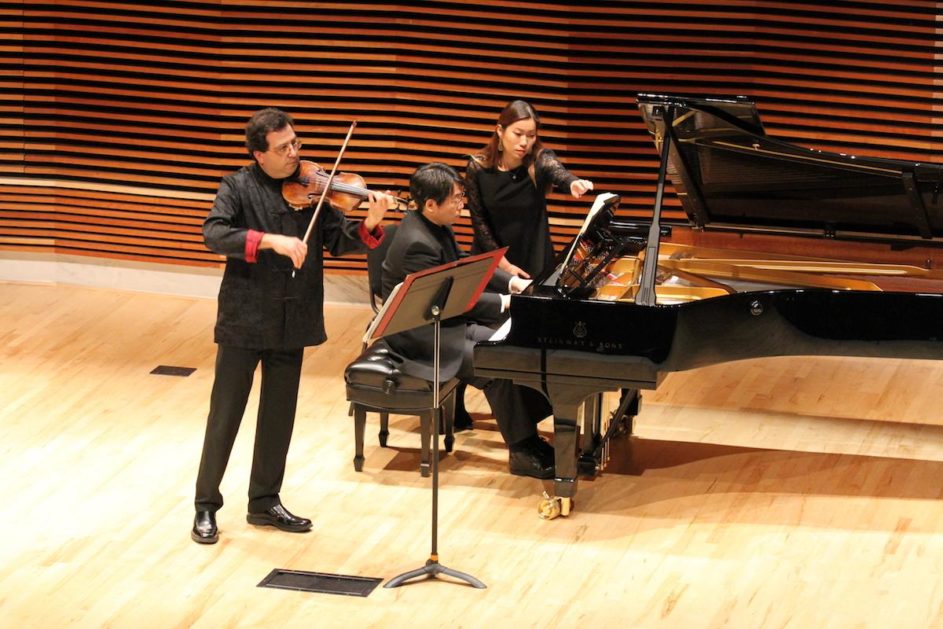Pianist Chih-Long Hu took off in arpeggio flourishes and trills that Miroslav Hristov’s violin had no choice but to jump into just to keep up in Beethoven’s 1801/02 “Sonata No. 8 in G Major,” Op. 30, No. 3, Monday night in the Powell Auditorium at UT’s Haslam School of Music.
It was the third and final concert in Hristov and Hu’s complete cycle of Beethoven’s violin sonatas for violin and piano.
Finally, there was a sonata in which the violin gave back everything the piano dished out. The arpeggios and trills were often bright and cheerful. At times the trills were little giggling gestures, enjoying the good time they were having.
In the second movement, a set of variations, the violin sang a calm, reassuring melody that verged on a lullaby. It kept coming back in each of the variations. In the third movement, the piano chattered away in what amounted to foreplay, while the violin carried out its part of the conversation with more restraint. They switched roles back and forth.
There was no doubting the sensuality in Beethoven’s 1803 “Sonata No. 9 in A Major,” Op. 47, which everyone knows as the “Kreutzer Sonata.” Beethoven wrote the sonata for George Polgreen Bridgetower, a gifted Afro-European violinist born in Poland but living in England, who premiered it. But Beethoven dedicated it to the French violinist Rudolphe Kreutzer, in hopes it would make an impression on the French for his upcoming trip to Paris. He never went because Napoleon destroyed the trip’s appeal. Despite the sonata’s overt emotions, it turned out that Kreutzer didn’t understand it and never played it.
Leo Tolstoy got its eroticism, to the point he wrote a story about a Russian aristocrat who murders his wife over her affair with her music partner and gets away with it. The novel was initially censored. Tolstoy had been a sex addict in his youth. He understood physical passions thoroughly, although at 61, when he wrote “The Kreutzer Sonata,” his views had changed.
Judging from the sonata, so did Beethoven. Hu played Beethoven’s passionate rampages on the piano while Hristov seductively plucked temptations on the violin strings. The ending of the first movement was almost orgasmic.
The second movement began with a caressing, seductive piano opening, with the violin joining in. As the piano continued, the violin luxuriated in the attentions. At moments, the violin was reduced to little stuttering phrases.
The third movement was a joyful, dancing celebration, the end of which brought roars of approval from the audience, most of whom had come specially to hear this piece.
The final piece on the program, “Sonata No. 10 in G Major,” Op. 96, written nine years after the “Kreutzer,” was a work of an entirely different order. It also had a great admirer, Franz Schubert, who liked the aesthetics of its quiet, pensive style.
The opening movement began with a delicate trill. There were shared arpeggios in both the piano and violin, with dramatic swells, along with other shared material and seamless exchanges between the voices. In the second movement, the violin sings a lovely melody with the restrained drama going on underneath in the piano. It built slowly into more expressive runs by both instruments, as well as irresistible, soaring moments. The third movement set off in a blitz with furious energy. The fourth movement was one of contrasts, at times pulling apart the timing and long arpeggios.
As an undertaking, these 10 sonatas over a span of three concerts were an impressive achievement for both musicians. The violin’s workload steadily increased from one sonata to the next with the last three being all out. Of course, as with most of chamber music ensembles involving a piano, Hu was a tireless workhorse from the first note of the first sonata to the last note of Op. 96.
Bravo to both Hristov and Hu.
This final concert in the series was the 88th concert in the Sandra G. Powell Recital Hall this school year. Almost all of them have been free to the public. Parking is almost always available for evening concerts in the parking lot behind the music center. More information about these always interesting events can be found at https://music.utk.edu/events/index.php.

